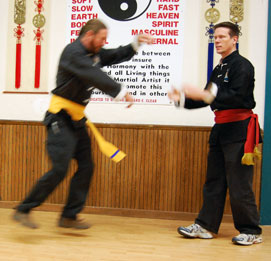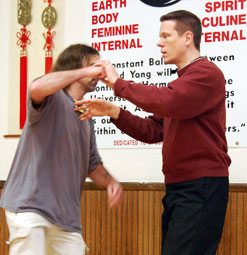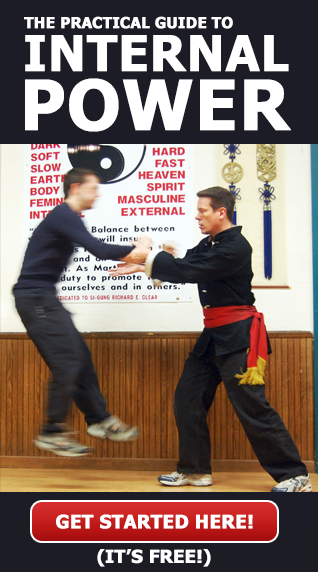- Open Hand strikes
- Punches
- Finger strikes
- Elbows & knees
- kicks & stomps
- Forearms
- shoulders & hips
- head butts and strikes with the back and the butt.
Use whole Body Power
In Tai Chi one of the principle ideas is to use the entire body weight to strike.
This can be accomplished by moving into the target with your entire body or by getting the target to come to you.
The Power of Internal Connection
Internal body connection is an important part of Tai Chi. Maintaining proper internal body connection while moving makes any movement or contact very powerful because your entire body weight is in each movement.
As an example, Tai Chi finger strikes are done with the fingers but the entire body is behind the strike so that the entire body weight gets transferred to and into the recipient.
If you get pushed with a Tai Chi finger strike it tends to feel like iron nails the size of fingers are digging into your skin.
Testing your internal connection
One of the tests that we use for internal body connection is to push our fingers into the palm of an actively resisting assistant.
To try this test for yourself get a willing partner who will stand solid and try not to be moved while you push into the middle of their palm with your fingers.
If they can stop you from moving them while you push your fingers into their palm then your technique is not quite there yet.
If the technique is right then the pushing force is overwhelming to them because your whole body is pushing through the end of your fingers which means you are getting a lot of PSI through a small area. One of the things to check for is any breaks in structure between your feet and your fingers. If you feel force in your wrist, elbow, shoulder, back, knee or anywhere else in between then you still have internal body connection work to do.
Here’s an example of how to check this type of connection.
Internal Power Transfer
Tai Chi Striking involves the transfer of internal power and often the force of the strike is directed to the weakest part of the recipient.
This involves internal sensitivity in order for the practitioner to be able to sense the weak area and then to direct force to that area instantly with a strike.

Often the visual result is that the recipient goes flying even though the Tai Chi practitioner only touched them.
Internal Striking
A beginning “internal” Tai Chi strike when the whole body weight to be transferred in the strike.
The recipient will feel this and may liken it to getting hit by a large tree trunk.
This is the first stage. At later stages the body weight may not be felt by the recipient but the effects of proper power transfer will be unmistakable.
Most often the visual result is that the recipient goes flying even though the Tai Chi Master only physically touched them.
Finding weakness in the opponent.
I am often asked:
How can the Tai Chi practitioner touch the recipient and instantly feel where the weak area is?
and…
How do I direct that force to the weak area with as little effort as possible?
The basic answer is that you need to work on as much hands on training as you can get where you are feeling into the other person’s body. After a good bit of practice you will learn how to feel the strengths and weaknesses inside of the other person and eventually you get good at it.
Once this occurs then you will graduate to being able to see and / or feel it without physical contact. Then, it becomes fairly easy to do higher level Tai Chi Striking where you do not put out much force but the recipient gets blown off of their feet.
How to get started.
You can get started right now with our free guide: How to build Internal Power. This will give you the basics for building both the power transfer and internal sensitivty that we’ve talked about above.
Please practice carefully
When this kind of striking power is done correctly the practitioner may not feel like they are doing much of anything but the recipient receives a lot of force even if the reason they receive it is due to their own weakness and lack of internal body connection.
Good training to you and yours.
Until next time.


On more than 1 occasion I have been “fortunate” enough to be the “test dummy” in the demonstration of finger tip strikes.
The first strike hit the shoulder joint area between the uppermost rib and the shoulder itself. That strike caused temporary paralysis on the part and side of body struck.
A few days later, a 2nd strike in the same area left me feeling like I was going to start yawning in technicolor – make street pizza – or you may use what ever your favorite term for regurgitation may be.
These strikes were not exceptionally hard or fast – fortunately -but were simple demos to show proper alignment and/or the application of techniques used when the situation does not warrant totally incapacitating some douche bag.
The ability to execute effective finger tip strikes is a weapon that should be included in everyone’s arsenal.
Train Hard – Stay Safe